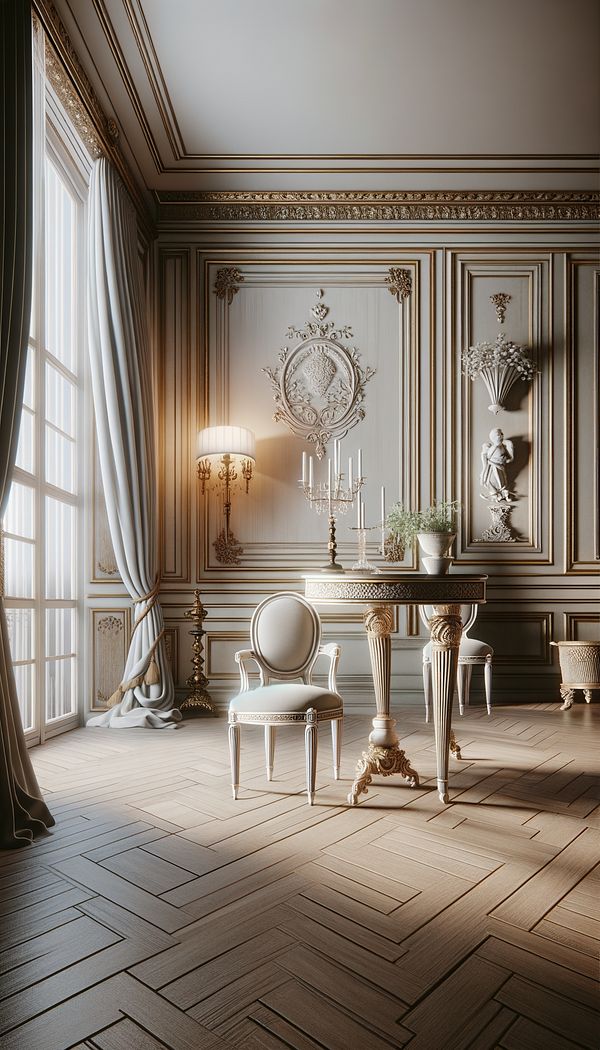What is Directoire?
Directoire refers to a style of design inspired by the period of the Directory government in France.
Description
Directoire style, named after the Directory government that ruled France from 1795 to 1799, marks a transitional period in French design, nestled between the opulent Louis XVI and the more somber Empire styles. This style embodies a refinement and simplicity that was a reaction against the excesses of the preceding Rococo period. It was a time when neoclassical influences were increasingly prominent, drawing inspiration from ancient Greece and Rome, as well as Egypt, as a result of Napoleon's campaigns.
Directoire furniture and interior design are characterized by their elegant simplicity, clean lines, and minimal ornamental detailing. Motifs from classical antiquity, such as Greek keys, lyres, and bucrania, are common, but are rendered with restraint. Materials like mahogany and brass were popular, along with lighter fabric choices for upholstery. The Directoire style emphasizes functionality and a less-is-more approach, foreshadowing the sleeker designs of the Empire style that followed.
The impact of the Directoire style has been enduring, with its influence visible in various forms of interior design, architecture, and even fashion. Its blend of classical motifs with a minimalist approach has made it a timeless choice for those seeking elegance without opulence.
Usage
In a modern context, Directoire style can be incorporated into home interiors through the use of furniture pieces that echo the period's distinct characteristics, such as straight-legged chairs, simple yet elegant tables, and decorative objects featuring neoclassical motifs. It also serves as an inspiration for interior designers seeking to create spaces that balance classical elegance with minimalist sensibilities.
FAQs
-
How does Directoire style differ from Louis XVI and Empire styles?
Directoire style is more restrained and less ornate than the Louis XVI style, with a stronger focus on simplicity and functionality. It is a transition between the opulence of Louis XVI and the somber, monumental quality of the Empire style, embodying neoclassical influences with a minimalist approach.
-
What are typical materials and motifs found in Directoire style?
Common materials include mahogany wood and brass, while motifs feature classical elements like Greek keys, lyres, and bucrania, presented with elegance and restraint.
-
Can Directoire style be applied in contemporary interior design?
Yes, Directoire style can be seamlessly integrated into contemporary interiors by selecting furniture and decor that reflect its characteristics of elegance, simplicity, and minimalism, making it a timeless choice for modern homes.
Practical Application
To infuse your space with the charm of the Directoire style, focus on selecting furniture pieces that embody the era's hallmark simplicity and refinement. Opt for streamlined forms, classical motifs presented with restraint, and a restrained color palette. Incorporate light, airy fabrics for upholstery and window treatments, and choose decorative elements that hint at antiquity without overwhelming the space.
-
Design Styles478 articles
-
Furniture Types599 articles
-
Decorative Objects240 articles
-
Historical Periods & Movements150 articles
-
Goblet PleatA type of curtain heading that resembles the shape of a goblet.
-
AfghanIn interior design, 'afghan' typically refers to a handcrafted blanket or throw, often knitted or crocheted.
-
Rococo RevivalRococo Revival is a 19th-century furniture and interior design style that draws inspiration from the 18th-century French Rococo period.
-
Counter StoolA counter stool is a tall, narrow chair designed for use at a kitchen counter or bar.
-
LayeringLayering in interior design is the process of adding multiple elements together to create depth, interest, and balance within a space.
